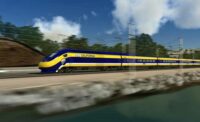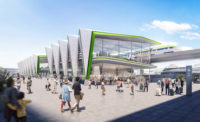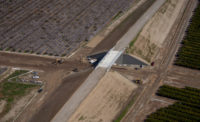A critical 90-mile section of California’s high-speed rail extending the system from the Central Valley into the San Francisco Bay Area has been unanimously approved by the High-Speed Rail (HSR) Authority Board of Directors.
The Final Environmental Impact Report/Environmental Impact Statement (EIR/EIS) for the San Jose to Merced project section in Northern California was approved by the board on April 28. The action completes the environmental clearance for nearly 400 miles of its entire 500-mile Phase 1 alignment from San Francisco to Los Angeles/Anaheim.
With the environmental process complete, the High Speed Rail Authority—the entity responsible for planning, designing, building and operating the nation’s first high-speed rail system—now has a plan moving forward, says HSR spokesman Anthony Lopez.
“We know what the alignment will be and where we will be building, and generally the approach we are going to take with that alignment,” he says.
The next step is the design-build and preconstruction phase, which can begin as soon as funding is secured, says Lopez. In the meantime, he says the main focus of work is in the Central Valley, where there are 35 active job sites spanning 119 miles.
“The 119 miles will serve as a test and certification track (for the HSR project), as there is currently no place planned or under construction anywhere in the country where we could achieve our voter mandated speeds of 200-plus miles per hour,” says Lopez.
The planned San Jose to Merced project section will connect the existing construction in the Central Valley to San Jose’s Diridon Station, the city’s central passenger rail depot and a major intermodal transit center for Santa Clara County and Silicon Valley. Officials say the high-speed rail system will make the trip from Fresno to San Jose in one hour, compared to three hours by car today.
 The San Jose to Merced project section in Northern California extends the high-speed rail route from the Central Valley
The San Jose to Merced project section in Northern California extends the high-speed rail route from the Central ValleyImage courtesy of California High-Speed Rail
The certification of the final EIR/EIS and approval of the San Jose to Merced section moves the project closer to being “shovel ready” when pre-construction and construction funding becomes available. For this portion, Alternative 4 was selected as the approved alignment among four alternatives studied. This plan modernizes and electrifies the existing rail corridor between San Jose and Gilroy, allowing for both high-speed rail and Caltrain service.
East of Gilroy, the alignment includes more than 15 miles of tunnels through the Pacheco Pass in the rugged Diablo Range. The project faces significant challenges in this area due to poor-quality rock formations, faults and shear zones, and potentially high groundwater inflows that can affect tunnel stability. Additionally there are risks for biological and natural resources.
“To design the safest possible tunnels, the Authority is using the best available practices from around the world,” says HSR Northern California regional director Boris Lipkin. “Preliminary engineering analyses have identified tunnel boring machines (TBM) as the most likely means of construction for the tunnels.”
Besides approving the San Jose to Merced portion, the Rail Board on April 28 also:
- Approved moving forward with the design of the four stations (Merced, Fresno, Kings-Tulare and Bakersfield) in the Central Valley
- Approved a multi-million dollar funding and planning agreement with the Los Angeles Metropolitan Transit Authority (LA Metro) to modernize the historic LA Union Station through the Link Union Station (Link US) project
The rail authority has previously cleared four project sections of the high-speed rail project prior to issuing the San Jose to Merced project section environmental document. Last fall, it approved the Bakersfield to Palmdale project section, and in January, it completed its CEQA approval for the Burbank to Los Angeles section. Prior to these approvals, it approved the Fresno to Bakersfield project section and the Merced to Fresno project section.






Post a comment to this article
Report Abusive Comment